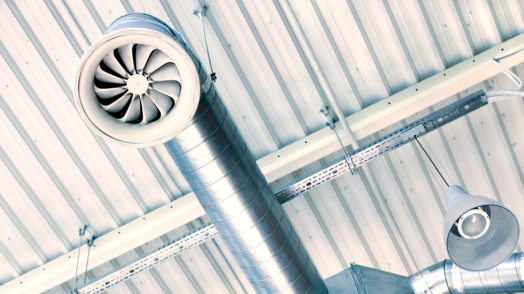How Does a Ventilation System Work?
UK health and safety laws mandate that employers take necessary measures to protect their employees, and effective ventilation is a critical component of these measures. Understanding how ventilation systems work and their role in maintaining air quality helps employers meet their legal obligations and ensures a safer working environment for everyone.
This article explores the importance of workplace ventilation, explains how a ventilation system works and discusses how it helps employers comply with UK regulations.
What Is a Ventilation System?
A ventilation system combines components to introduce fresh air into an enclosed space and remove contaminated air. Its primary goal is to ensure an adequate supply of clean air while controlling harmful pollutants, odours, and excess moisture.
Ventilation systems are pivotal in controlling airborne contaminants and ensuring they remain below the Workplace Exposure Limit. These systems can be classified into two main types: general (dilution) ventilation and local exhaust ventilation (LEV).
General (Dilution) Ventilation
General ventilation involves diluting contaminated air with clean, fresh air to reduce the concentration of hazardous substances. This method is typically used in less hazardous environments or where contaminants are not localised. It includes natural ventilation (e.g., windows, vents) and mechanical ventilation (e.g., fans, HVAC systems).
Local Exhaust Ventilation (LEV)
LEV systems are more effective in controlling airborne contaminants at the source. These systems capture and remove contaminants directly from the point of origin before they disperse into the workplace environment. LEV systems are critical in industries where high levels of dust, fumes, or vapours are produced, such as welding, painting, and chemical processing.
Both general and LEV systems share some common elements, although LEV systems are typically more complex and specialised.
The Importance of Ventilation Systems
Workplaces can be sources of numerous airborne contaminants, including dust, fumes, vapours, and biological agents. Prolonged exposure to these contaminants can lead to serious health issues such as respiratory problems, allergic reactions, and occupational diseases.
The Health and Safety at Work Act 1974 is the primary legislation governing workplace health and safety in the UK. Under this act, employers have a legal duty to provide and maintain a safe working environment.
When it comes to airborne contaminants such as dust, fumes, gases, and vapours, COSHH Regulations 2002 set specific requirements to ensure that employers keep exposure levels to hazardous substances as low as reasonably practicable and do not exceed the Workplace Exposure Limits (WELs) set by the Health and Safety Executive (HSE).
Ventilation systems help control and reduce the concentration of these harmful substances, ensuring they remain below the threshold limit values set by these regulatory bodies.
How a Ventilation System Works
- Air Capture: Contaminated air is captured using a hood. The hood’s design is critical for effective capture, considering factors such as the type of contaminant, its dispersal pattern, and the working environment. In LEV systems, hoods are placed as close as possible to the source of contamination.
- Air Transportation: Ducts transport the contaminated air from the hoods to the air cleaning device or exhaust point. Duct design is crucial for maintaining efficient airflow and preventing blockages.
- Air Cleaning: The air passes through filters or air-cleaning devices that remove contaminants. Depending on the contaminants’ nature, different types of filters (e.g., HEPA filters, and electrostatic precipitators) are used.
- Air Exhaust: Cleaned air is recirculated back into the workplace or exhausted outside. In some cases, especially where highly toxic substances are involved, air may need further treatment before being released into the atmosphere.
- Fresh Air Supply: In general ventilation systems, fresh air is supplied to dilute contaminants. This can be achieved through natural means (e.g., open windows) or mechanical systems (e.g., HVAC units).
Overall, ventilation systems are indispensable in maintaining workplace exposure limits and ensuring the safety and health of employees. These systems help control air quality and comply with regulatory standards by diluting, extracting, and filtering airborne contaminants. Investing in effective ventilation solutions is a legal obligation and a crucial step toward creating a safe, healthy, and productive workplace.
We design, manufacture, and install comprehensive ventilation systems tailored to the specific needs of various industries. Explore our services or contact us to discuss your requirements.

